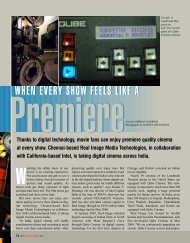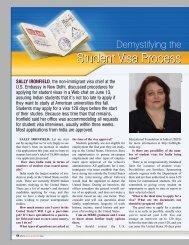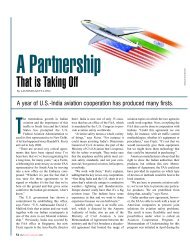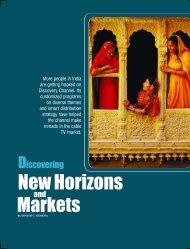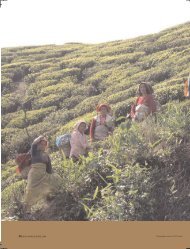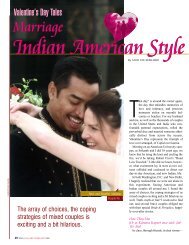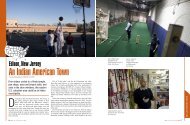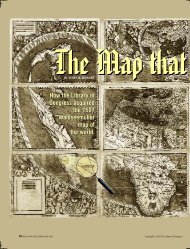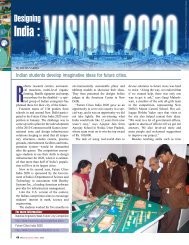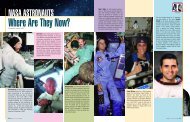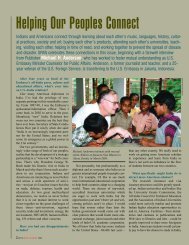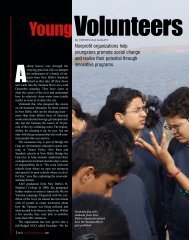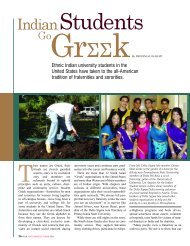Heartland Rock, SPAN November/December 2007
Heartland Rock, SPAN November/December 2007
Heartland Rock, SPAN November/December 2007
Create successful ePaper yourself
Turn your PDF publications into a flip-book with our unique Google optimized e-Paper software.
Born in the <strong>Heartland</strong><br />
Growing up in a small town in the Midwest meant playing every summer<br />
day outdoors, coming in after dark only when your mother called for you. It<br />
meant snowball fights and making snowmen in the winter. In the fall, it meant<br />
raking leaves all day into piles and then running and jumping in them. And in<br />
the spring, it meant waiting for the last huge chunk of ice to melt on the driveway<br />
under the basketball hoop so you would not fall down playing “horse!”<br />
It meant running through backyards with no fences, riding your bike everywhere<br />
in town, your dog following you to school and waiting for you when you<br />
got out. It meant family picnics in the field at the old Mulford farm, throwing<br />
dirt balls into the stream and standing barefoot in the ice cold spring water<br />
where the watercress grew.<br />
It meant doing everything as a family, from eating meals together to shoveling<br />
snow, from playing baseball to spring-cleaning the house, from taking<br />
family vacations in northern Wisconsin to replacing the storm windows with<br />
screens in summer.<br />
It meant hard work and happiness, but most of all, it meant freedom.<br />
—Ambassador David C. Mulford, born in <strong>Rock</strong>ford, Illinois<br />
this, even as they experience difficulties<br />
and frustrations.<br />
Many of these feelings found expression<br />
in a style of rock music that emerged<br />
in the late 1970s. In contrast to many of<br />
the popular groups of the era, the artists<br />
who played “heartland rock” were not<br />
theatrical. Instead of elaborate stage-sets<br />
and costumes, they came out in T-shirts<br />
and jeans; instead of synthesizers and programmed<br />
electronic percussion, they<br />
brought out guitars and backed up their<br />
songs with a strong beat from a traditional<br />
rock drum kit. In their personal lives,<br />
too, these artists tended to stay or return to<br />
their home communities, rather than living<br />
a glamorous lifestyle in New York or<br />
Los Angeles.<br />
According to the All Music Guide<br />
(www.allmusic.com/), a database of<br />
music, “At its core, heartland rock was<br />
straightforward rock ’n’ roll infused with<br />
Americana—more streamlined than garage<br />
rock, but not as traditionalist as roots<br />
rock.”<br />
The All Music Guide also notes that<br />
work in this style, “was united by the<br />
attitude that music should be about<br />
something.”<br />
What it is about is the lives, dreams and<br />
disappointments of ordinary working people,<br />
usually those in rural areas. An entry<br />
Willie Nelson (left) and Neil Young at the<br />
21st annual Farm Aid concert in Camden,<br />
New Jersey, in 2006.<br />
4 <strong>SPAN</strong> NOVEMBER/DECEMBER <strong>2007</strong><br />
PAUL NATKIN/Photo Reserve Inc. 2006<br />
in the online encyclopedia Wikipedia says<br />
the theme of isolation is central to heartland<br />
rock.<br />
This can be seen in the songs of the<br />
most prominent rockers in this style:<br />
Bruce Springsteen, Tom Petty, John<br />
Mellencamp and Bob Seger. Many of<br />
Springsteen’s songs, like “Promised<br />
Land,” speak bitterly of the broken promise<br />
of America. His song “Born in the<br />
U.S.A.” has a refrain that sounds like a<br />
proud patriotic anthem. Yet, the verses<br />
describe the pain of a returned war veteran<br />
finding it hard to make his way in life<br />
back home. In “Night Moves,” Bob Seger<br />
sings of the yearning of young lovers and<br />
romantic encounters “out past the corn<br />
Ambassador David C. Mulford and his wife,<br />
Jeannie, at Roosevelt House with their silkscreen<br />
color print by Italian artist Nicola<br />
Simbari. It depicts a typical American<br />
Midwest scene—a young girl riding her bike<br />
in the backyard, with sheets drying on the<br />
clothesline. The Ambassador says the picture<br />
makes him think of his wife as a child<br />
growing up in the small town of Hastings in<br />
Nebraska.<br />
fields where the woods get heavy.” “Look<br />
at the stars,” he sings in another song,<br />
“they’re so far away.”<br />
Mellencamp was born in the state of<br />
Indiana in a town called Seymour. It was<br />
founded in the mid-1800s at the intersection<br />
of two railroads on the Great Plains.<br />
Hemant Bhatnagar



